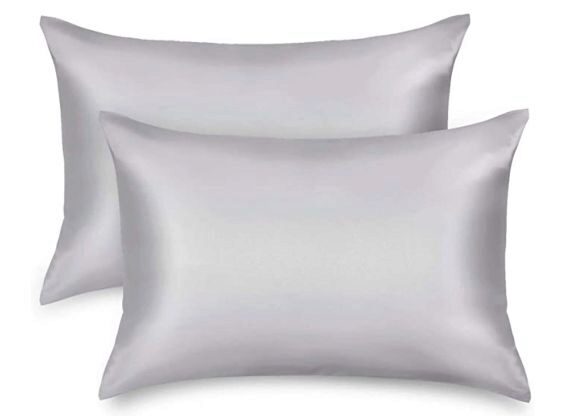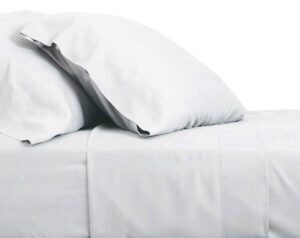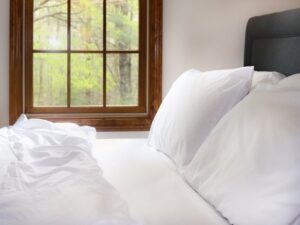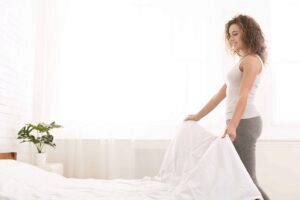Benefits of a Silk Pillowcase
Silk pillowcases can help prevent wrinkles and preserve your hair overnight..
Disclosure: By clicking on the product links in this article, Mattress Nerd may receive a commission fee at no cost to you, the reader. Read full disclosure statement.
“Beauty sleep” goes beyond getting enough hours in your REM cycle. What you sleep on can matter just as much.
Traditionally, cotton and polyester pillowcases have been the go-to choice because they’re inexpensive and widely available. But more and more people are making the switch to silk in the name of better hair and skin. Let’s see if the science backs this up.
5 Benefits of a Silk Pillowcase
Other than being soft and smooth, silk pillowcases offer a number of benefits that cotton and polyester pillowcases can’t touch. Here are just a few reasons why you should consider going silk.
Silk Pillowcases May Prevent Hair Breakage
Waking up with a tangled, matted mane? Your pillowcase could be to blame. Cotton and polyester are absorbent materials, which means they pull moisture away from your hair while you sleep. This can lead to breakage and split ends over time.
Silk, on the other hand, is a smooth fabric that won’t snag or pull on your hair as much. It has more slip, which allows your hair to slide around instead of getting tugged. Unlike other materials, it can actually help your strands retain moisture, leading to less breakage and fewer split ends.
Curly and natural hair types, in particular, may notice the biggest difference, but those with straight and fine hair will reap the no-friction benefits, too. Coloring your hair can make it weaker and more prone to breakage, so a silk pillowcase can also help retain the health of your colored hair.
It May Help Prevent Wrinkles
How you sleep tends to show up on your face the next day. If you’re a side or stomach sleeper who’s pressing your face into a crease-filled pillow for hours on end, you could be doing some damage in the wrinkle department, if that matters to you.
Silk pillowcases offer a smoother surface for your skin to rest on. While more research needs to be done on how preventive sleeping on a silk pillowcase can be, one study did find that sleeping on a copper pillowcase resulted in a “reduction of wrinkles depth and overall improvement of skin appearance.” Something that cotton could never do.
It May Soothe Irritated Skin
Rough fabrics can irritate the skin—especially if you have eczema, rosacea, or any other inflammatory conditions. This is why many people with sensitive skin opt for silk pillowcases. The fabric is smooth and gentle on the skin, making it ideal for those who are easily irritated.
One study of people with eczema found that wearing all silk clothing led to a reduction in symptoms like itching and dryness. While you might not want to replace all your clothes with silk, trading in your cotton pillowcase for a silk one may help soothe your skin woes.
It Stays Cleaner For Longer
We often hear about the amounts of bacteria we find on our phone screens and makeup brushes, but our pillowcases aren’t usually brought into the conversation. Cotton and polyester may actually harbor bacteria, which makes them a less-than-ideal material to rest your face on every night.
Though silk has long been praised for having antibacterial properties, clinical evidence hasn’t yet confirmed that it can actually prevent bacteria from reaching our skin. However, silk does absorb less moisture than other fabrics, which means it’s less of a breeding ground for bacteria in the first place. And you’ll enjoy a more hydrated complexion.
It Can Keep You Cool
Hot sleepers, rejoice! The cooling touch of silk can help you regulate your body temperature as you sleep, meaning you’ll be less likely to wake up feeling sweaty and gross. Cotton pillowcases tend to absorb heat, which can leave you feeling warm and clammy in the middle of the night. Silk offers a more cool-feeling option, making it ideal for those who tend to overheat when they sleep.

Popular Silk Pillowcases
Ready to start getting some real beauty sleep? Check out these popular silk pillowcases that can help keep you cool, comfortable, and wrinkle-free all night long.
ZIMASILK 100% Mulberry Silk Pillowcase
Most of the silky fabrics you’ll find on your Instagram feed come with a very high price tag—but not this brand. This 100 percent mulberry silk pillowcase is gentle on your skin and hair and comes in over 30 colors and patterns, all under $30.
Slip Silk Queen Pillowcase
This ultra-luxe option is beloved by celebs and other people alike. Not only was it developed by a dermatologist, but it’s also made with 22 momme silk, meaning it’s one of the highest-quality fabrics on the market. The only downside is that it comes with a high price tag to match.
TAFTS 22mm 100% Pure Mulberry 6A Silk Pillowcase
If you’re looking for an affordable option that doesn’t skimp on quality, TAFTS is your best bet. This pillowcase is made with 100 percent pure mulberry silk and has a luxurious 22 momme weight (just like that high-dollar Slip Silk). Reviewers love how gentle it is on the strands—especially for those with curly hair.
Alternatives to Silk Pillowcases
Switching to a cooling pillowcase is definitely one way to improve your complexion and take care of your mane—but silk is nowhere near the miracle worker some brands claim it to be. If you’re not interested in shelling out the big bucks for a silk pillowcase, there are plenty of other ways to keep your skin and hair healthy. Such as:
- Try other silky pillowcase materials. Satin or sateen sheets, bamboo sheets, or other sily materials, preferably with a good thread count can also be helpful.
- Limit your use of heat-based tools. We love a wavy blowout as much as the next person, but constantly subjecting your hair to heat can do some damage. Overusing heat-based styling tools (especially without a heat protectant) can lead to dryness, breakage, and frizz.
- Wash your pillowcases regularly. No matter what material your pillowcase is made of, it’s important to wash it frequently, as bacteria and sweat can build up on the fabric and transfer to your skin. To keep things clean, aim to wash your pillowcases at least once a week.
- Keep consistent skin care and hair care routines. The best way to make sure your skin and hair are healthy is to develop a regular care routine and stick to it. Everyone’s routine will be different, but finding what keeps your complexion and strands looking their best will make a world of difference. A dermatologist can help.
- Drink plenty of water. Staying hydrated is key to glowy skin and strong strands, so make sure you’re drinking enough H2O every day. A good rule of thumb is to drink eight glasses of water per day, but you may need more or less depending on your diet and lifestyle. Humidifiers can also keep the air moist for more hydrated hair and skin.
Takeaway
Using a silk pillowcase won’t magically clear up your skin or moisturize your hair if you’re always subjecting it to hot tools. The foundations of good skin and hair care are still the same, no matter what type of pillowcase you use.
That being said, silk pillowcases can be another helpful tool in your beauty arsenal—especially if you’re looking to cut down on wrinkles or preserve your hair overnight. If you’re looking for an extra layer of luxury that doubles as a way to take care of your skin and hair, a silk pillowcase may just be worth the investment.
Sources
Anson G, et al. (2016). Sleep Wrinkles: Facial Aging and Facial Distortion During Sleep. https://academic.oup.com/asj/article/36/8/931/2613967
Baek J, (2012). Reduction of facial wrinkles depth by sleeping on copper oxide-containing pillowcases: a double blind, placebo controlled, parallel, randomized clinical study. https://pubmed.ncbi.nlm.nih.gov/22938003/
Callewaert C, et al. (2014). Microbial Odor Profile of Polyester and Cotton Clothes after a Fitness Session. https://www.ncbi.nlm.nih.gov/pmc/articles/PMC4249026/
Carefoot H. (2021). Silk pillowcases may provide some hair and skin benefits, but they’re not miracle workers. https://www.washingtonpost.com/lifestyle/wellness/silk-pillowcases-hair-skin-benefits-myths/2021/04/05/a7dcad7c-866a-11eb-82bc-e58213caa38e_story.html
Hung M-H, et al. (2019). Influence of silk clothing therapy in patients with atopic dermatitis. https://www.ncbi.nlm.nih.gov/pmc/articles/PMC7137929/
Yamada A. (1998). The absorbing rate of moisture for silk fabric comparing to other fabrics made from various fibers. https://www.jstage.jst.go.jp/article/kontyushigen1930/67/4/67_4_333/_article


